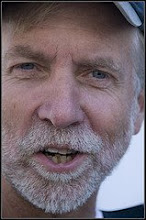Shift #8
CASUAL FRIDAY, JANUARY 22 -- 12:32 p.m. -- Beale/Folsom to Montgomery/Pine -- $5.35
HE WALKS OUT OF THE BRIDGESIDE (an apartment tower at 400 Beale Street, just a few blocks from the Giants baseball stadium) carrying a complicated folder/clipboard-looking sort of thing and a Blackberry. He’s wearing a goatee and Dockers and a checked, long-sleeve, “Casual Friday” dress/sport shirt. Like me, he is white and middle-aged, but I imagine that he still thinks of himself (especially on Casual Friday) as a young guy. I gave that up a while back.
He’s going to 473 Pine, right in the heart of the Financial District. Mentally I plot my route -- a quick U-turn, a right onto Folsom, a left onto Main and then another onto Market, a right at Pine and four and a half-blocks up...easy. Coming out of my U-turn I start to ask him “What’s your day hold?” -- but a quick glance in the rearview shows him tapping away, grinning down at his Blackberry...
On NPR a professor from the University of Texas is talking about the proliferation of cameras in public life. People in the big cities of Britian and the United States are now photographed approximately 40 times per day. Recent advances in both digital photography and facial-recognition software have allowed for the creation of huge databases enabling authorities to scan train stations, streets, shopping areas, airports -- any place a camera might be mounted -- and to identify anyone who is in the database and also within view. Many states now take digital photographs for drivers licenses and share those images with other states. Already, people passing through Customs in Australia step in front of a machine that scans their facial features and compares them to the digital photos in their passports.
Is all of this good, bad, a combination? I’m not sure. But...
IN 1994, AS THE HEAD of a group of (barely) organized San Francisco cab drivers (United Taxicab Workers), I saw all of the San Francisco Police Department reports involving cab drivers. That year, there were approximately 100 robberies of cab drivers, which was a pretty typical year back then.
Cab robberies used to come in waves: some punk would get it in his head that he could make a little easy money just by flagging a cab -- and usually he was right. One serial robber would reach around from the backseat and snap a chokehold on the driver: “Give it up, motherfucker.” A police artist sketch of The Choker’s face appeared on the front page of every paper, but, somehow, cab drivers still kept picking him up. In the space of six weeks he robbed he managed to knock off about thirty of us. But the police do have their ways, and they soon figured out exactly which lowlife was causing all the mayhem, and one night when The Choker was in the city they tailed him. When he caught on, The Choker tried to jump a BART train out of the city, and that’s when the police moved in. I think he’s still in jail.
Finally, in 2002, after a years-long debate about driver safety, the San Francisco Board of Supervisors decreed that every cab in the city would be equipped with an onboard camera. And now, whenever the door of a San Francisco taxi is opened or closed, an in-cab camera with a fish-eye lens snaps a photo of the entire interior. (It also snaps photos under certain other circumstances, but those details are highly-guarded information, and if I revealed them to you I would have to... well, I would have to at least snap a chokehold on you and make you swear not to tell.)
About a month after their installation, one of the cameras snapped a photo of two young punks sitting in the backseat of a cab; one of them is holding a great big handgun and aiming it at the driver, whose face, in the photo, shows unmistakable terror. The two punks are sporting smug, confident grins. The cops who downloaded the images said, “Hey! We know those guys.” They rolled by the punks’ houses and picked up both of them. When word got around, the number of cab driver robberies plummeted, almost overnight, from approximately 100 per year to approximately fifteen per year, a number which has held steady ever since.
“It’s just here!” There is alarm in my passenger’s voice.
“Ooops…!” Lost in my head, I’ve almost driven past 473 Pine. “I forgot you were back there,” I tell him, and pull over.
He laughs, and extends his credit card toward me.
I punch off the meter, turn around, look him in the eye, and say, “Every day I give away one free ride, and I’d like this to be my free ride today.”
“Really?” His face contorts with two waves of confusion -- one wave cascades from top to bottom, the other rips from side to side -- and then settles into a tentative smile.
“Yes,” I say. “If that’s all right with you.”
“That’s just great,” he says. “Thank you.”
------------------------------------------------------------------------------------
Subscribe to:
Post Comments (Atom)

No comments:
Post a Comment